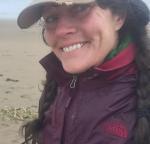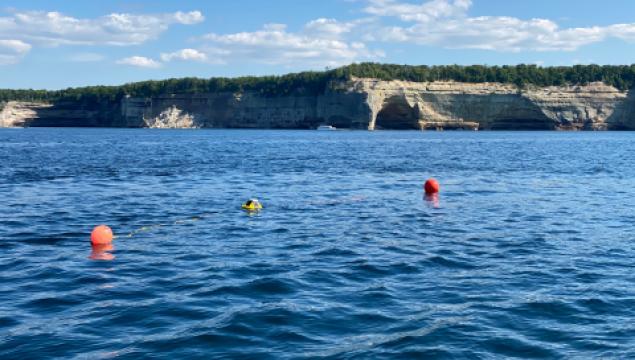Michigan Tech Great Lakes Buoy Network: Protecting Lives and Property from Hazardous Lake Conditions
Why This Project Is Important
The first Great Lakes weather buoys were deployed on Lake Superior in 1979, largely in response to the sinking of the Edmund Fitzgerald that occurred in November of 1975. Although there are estimated to be over 6,000 shipwrecks on the Great Lakes, it took the sinking of a 729-foot ore carrier to get the attention of federal agencies and raise awareness that big lakes have big storms. Since the time of the "Fitz," the buoy network on the Great Lakes has grown to include 2-3 offshore buoys near the central portion of each of the Great Lakes, providing valuable navigational aids to commercial shippers and recreational boaters. Starting around 2010, however, it began to be recognized that significant gaps in the buoy network existed along the thousands of miles of Great Lakes shoreline, which is also where most on-water recreation occurs (fishing, boating, swimming, etc.). Even the "shipwreck coast" of Lake Superior from Marquette to Whitefish Point did not have any nearshore weather buoys along its treacherous shoreline prior to 2015.
As the Great Lakes nearshore buoy network has expanded over the years, the value of the buoys to local communities has become clear. However, due to the complexities of Great Lakes shorelines, peninsulas, and islands, it is often the case that wind and wave conditions at one locale can be very different from another site just a few miles away. A good example of this is the Keweenaw Peninsula in Lake Superior, where Michigan Tech has been operating two nearshore buoys at the north and south entries of the Portage Canal since 2010. The north buoy is exposed to the full strength of NW autumn gales, while the south buoy is in a significantly sheltered bay (but still exposed to occasional NE gales). Hence, there is a significant need for funding to both maintain and also expand Michigan Tech's Great Lakes buoy network.
Project Description
The goal of this project is to maintain and improve upon Michigan Tech's life-saving buoy network on the Great Lakes. The buoys measure wave conditions, wind speed and direction, water temperature, water current speeds, and detailed meteorological information. The Michigan Tech Buoy Network (MTBN) contributes data to a broader observational network known as the Great Lakes Observing System (GLOS). Since 2010, the MTBN has grown from two buoys on Lake Superior to now 12 buoys that are operated throughout Lake Superior, northern Lake Michigan, and Northern Lake Huron. Funds from this project will be used to help support the continued operation and maintenance of the buoy network, including deployments, retrievals, repair and replacement of sensors, student research projects, education and outreach (e.g., informational kiosks), and even the potential expansion of the buoy program to new locations, funding permitting. Data collected by the network of buoys will be made available to the public in real time, as well as archived for Great Lakes scientists to use in research projects.
Meet the Researchers

Hayden Henderson
My work occurs at an intersection of engineering and ecosystems. Deployment of advanced observing systems, including real-time sensor networks and other oceanographic technology is necessary for support and validation of operational forecasting, early warning systems, and other developmental research used in the physical, biological, and chemical understanding of Great Lakes and coastal systems. The products made possible by these technologies aim to provide managers, public, and education sectors with the dense amount of information needed to understand physical science dynamics – all of which have implications for public safety, recreation, and further scientific study.

Guy Meadows
Upon graduation from Purdue University in 1977, Guy Meadows joined the faculty of the University of Michigan, College of Engineering, where he served as Professor of Physical Oceanography for 35 years. During his tenure, he served the College and University as Director of the Ocean Engineering Laboratory, Director of the Cooperative Institute for Limnology and Ecosystems Research (NOAA, Joint Institute), Director of the Marine Hydrodynamics Laboratories and founding Academic Director of the M-STEM Academy. He joined Michigan Tech in June of 2012, to help establish the new Great Lakes Research Center. His primary goal, to blend scientific understanding and technological advancements into environmentally sound engineering solutions for the marine environment, through teaching, research and service.
His teaching reaches beyond the University setting to less formal environments, and includes five nationally televised documentaries for the History and Discovery Channels. His primary research interests are in geophysical fluid dynamics with emphasis on environmental forecasting and full-scale, Great Lakes and coastal ocean experimental hydrodynamics. In this arena, he has influenced policy and explored societal impacts of environmental forecasting for...

Travis White
Travis has been a US Coast Guard licensed captain, currently holding a 50 ton master rating, on the Great Lakes since 2009 and logs on average over 100 days annually on the water. He received a Bachelor of Science in Mechanical Engineering from Michigan Technological University in 2011. In his role as a research engineer at the Great Lakes Research Center, he leads the Marine Autonomy Research Site and Smart Ships Coalition. His recent research includes autonomous vehicle behavior development, specifically intelligent trajectory planning and maneuvering in large sea states. Travis co-founded ProNav Marine, producer of marine GPS autopilot equipment and mobile navigation software. He serves as the relief captain for the university’s research vessel, Agassiz, and enjoys spending time on the water providing sportfishing charters during his leisure time.

Erika Vye
Dr. Erika Vye is a geologist and geoheritage specialist with expertise in formal and informal place-based education initiatives that broaden community Earth sciences and Great Lakes literacy. She is active in conservation and education initiatives that foster coastal community resilience through traditional knowledge, research, and citizen science on environmental issues ranging from shoreline erosion, increased storm surges, lake level rise, severe weather, climate change, and migration of legacy mining stamp sands. As the co-founder of Keweenaw Geoheritage and Keweenaw Geotours, she is active in the development of sustainable economic opportunities and educational initiatives that enrich peoples’ connections with coastal environments and has extensive experience on interpreting coastal features in the Lake Superior region. Vye is a Geosciences Research Scientist and part of the University-Indigenous Community Partnerships at the Great Lakes Research Center, Michigan Tech. She also serves on the Leadership Team for the Lake Superior Stewardship Initative and has planned and implemented numerous field trips, place-based stewardship projects, and teacher institutes with specific focus on coastal issues in the Lake Superior region.
days left
funded
last
What Your Donation Can Help Us Do:
- Prevent drownings, save lives, and protect property by deploying, maintaining, and retrieving weather buoys on the Great Lakes
- Purchase new buoys to expand the Great Lakes observational network
- Augment existing buoys with new sensors, webcams, and data management tools
- Increase awareness and utilization of the buoy network through education and outreach
- Perform research and data analysis to better understand and predict hazardous conditions on the Great Lakes
$10 2 Funders
Access to MTU buoy data through the Great Lakes Observing System (GLOS)
$100 6 Funders
E-mail updates on the progress of the project
Recent Donors
Some donors may be hidden.







 Gifts to projects listed on SUPERIORIDEAS.ORG are received and processed by Michigan Tech Fund. Michigan Tech Fund is a tax-exempt organization under Section 501(c)(3) of the Internal Revenue Code acting on behalf of Michigan Technological University. It is the policy of Michigan Tech Fund that a portion of the gifts and/or income therefrom may be used to defray the costs of raising and administering the funds.
Gifts to projects listed on SUPERIORIDEAS.ORG are received and processed by Michigan Tech Fund. Michigan Tech Fund is a tax-exempt organization under Section 501(c)(3) of the Internal Revenue Code acting on behalf of Michigan Technological University. It is the policy of Michigan Tech Fund that a portion of the gifts and/or income therefrom may be used to defray the costs of raising and administering the funds.